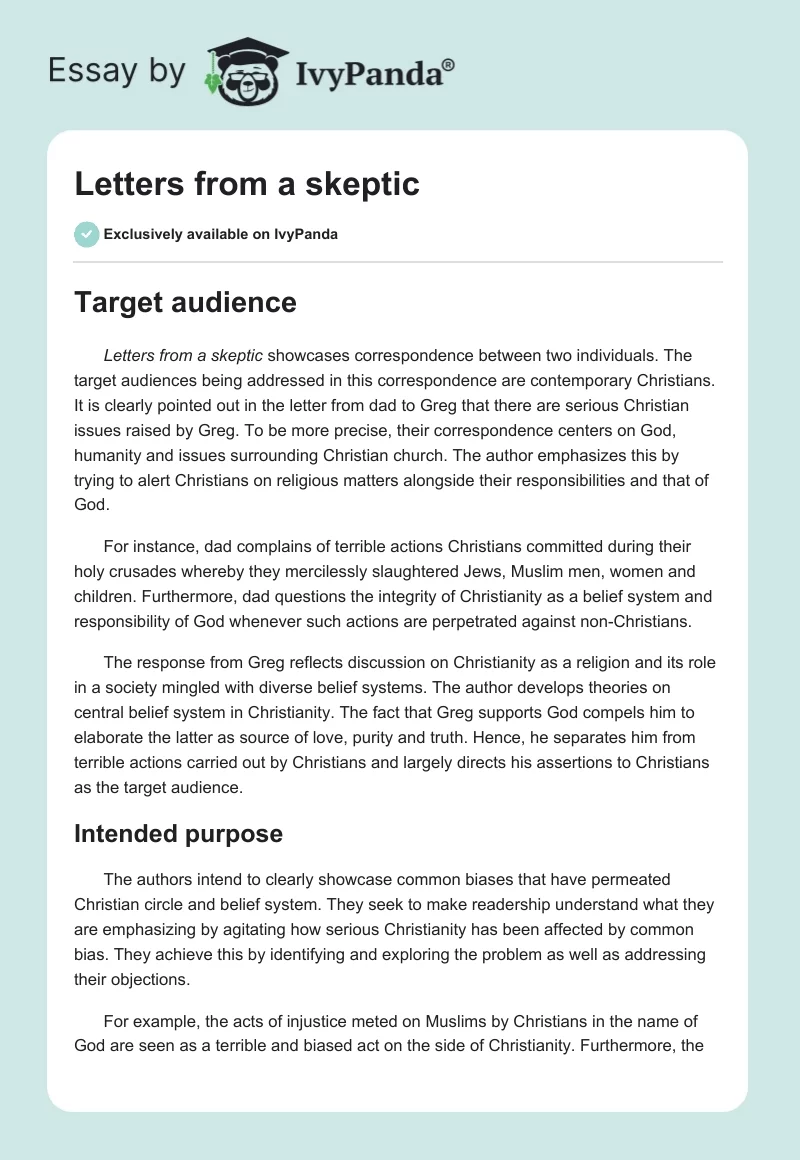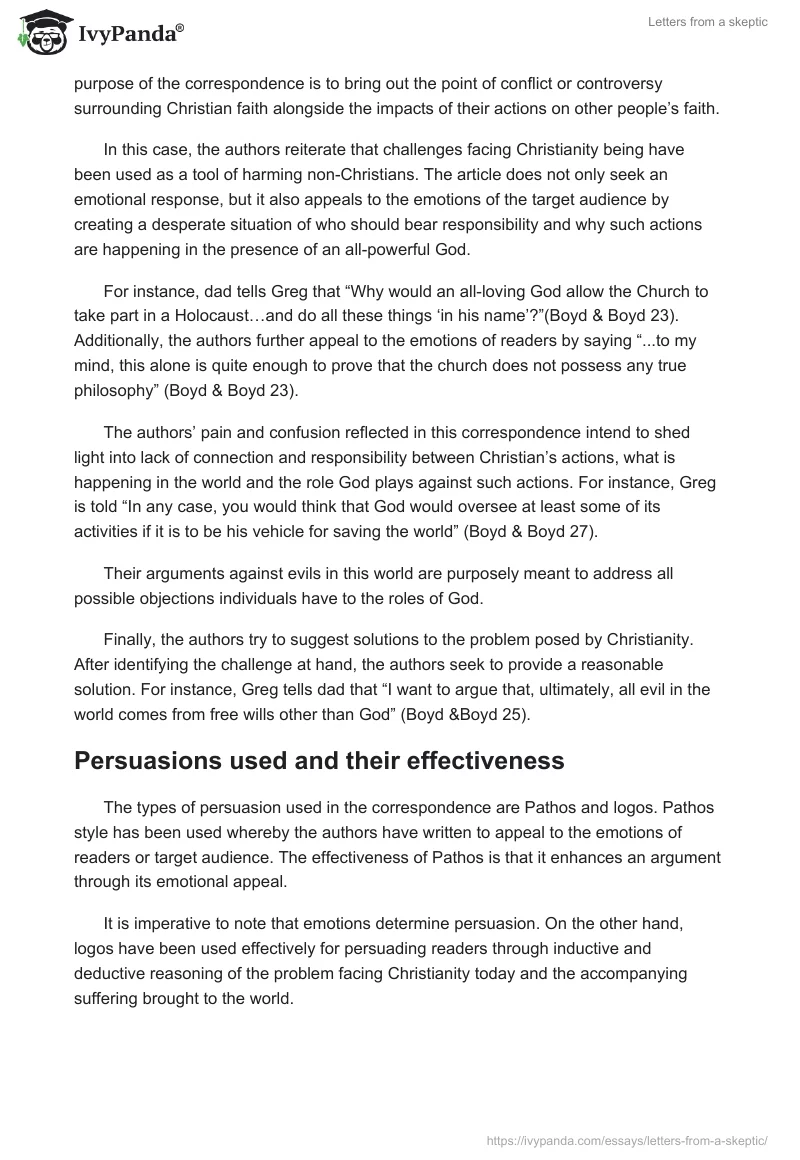Target audience
Letters from a skeptic showcases correspondence between two individuals. The target audiences being addressed in this correspondence are contemporary Christians. It is clearly pointed out in the letter from dad to Greg that there are serious Christian issues raised by Greg. To be more precise, their correspondence centers on God, humanity and issues surrounding Christian church. The author emphasizes this by trying to alert Christians on religious matters alongside their responsibilities and that of God.
For instance, dad complains of terrible actions Christians committed during their holy crusades whereby they mercilessly slaughtered Jews, Muslim men, women and children. Furthermore, dad questions the integrity of Christianity as a belief system and responsibility of God whenever such actions are perpetrated against non-Christians.
The response from Greg reflects discussion on Christianity as a religion and its role in a society mingled with diverse belief systems. The author develops theories on central belief system in Christianity. The fact that Greg supports God compels him to elaborate the latter as source of love, purity and truth. Hence, he separates him from terrible actions carried out by Christians and largely directs his assertions to Christians as the target audience.
Intended purpose
The authors intend to clearly showcase common biases that have permeated Christian circle and belief system. They seek to make readership understand what they are emphasizing by agitating how serious Christianity has been affected by common bias. They achieve this by identifying and exploring the problem as well as addressing their objections.
For example, the acts of injustice meted on Muslims by Christians in the name of God are seen as a terrible and biased act on the side of Christianity. Furthermore, the purpose of the correspondence is to bring out the point of conflict or controversy surrounding Christian faith alongside the impacts of their actions on other people’s faith.
In this case, the authors reiterate that challenges facing Christianity being have been used as a tool of harming non-Christians. The article does not only seek an emotional response, but it also appeals to the emotions of the target audience by creating a desperate situation of who should bear responsibility and why such actions are happening in the presence of an all-powerful God.
For instance, dad tells Greg that “Why would an all-loving God allow the Church to take part in a Holocaust…and do all these things ‘in his name’?”(Boyd & Boyd 23). Additionally, the authors further appeal to the emotions of readers by saying “…to my mind, this alone is quite enough to prove that the church does not possess any true philosophy” (Boyd & Boyd 23).
The authors’ pain and confusion reflected in this correspondence intend to shed light into lack of connection and responsibility between Christian’s actions, what is happening in the world and the role God plays against such actions. For instance, Greg is told “In any case, you would think that God would oversee at least some of its activities if it is to be his vehicle for saving the world” (Boyd & Boyd 27).
Their arguments against evils in this world are purposely meant to address all possible objections individuals have to the roles of God.
Finally, the authors try to suggest solutions to the problem posed by Christianity. After identifying the challenge at hand, the authors seek to provide a reasonable solution. For instance, Greg tells dad that “I want to argue that, ultimately, all evil in the world comes from free wills other than God” (Boyd &Boyd 25).
Persuasions used and their effectiveness
The types of persuasion used in the correspondence are Pathos and logos. Pathos style has been used whereby the authors have written to appeal to the emotions of readers or target audience. The effectiveness of Pathos is that it enhances an argument through its emotional appeal.
It is imperative to note that emotions determine persuasion. On the other hand, logos have been used effectively for persuading readers through inductive and deductive reasoning of the problem facing Christianity today and the accompanying suffering brought to the world.
Sub merge
Target audience
The target audience in the article Sub-merge are Christians. This can be supported by the author’s call for all Christians in the kingdom of God to examine their culture. The author addresses the issues of poverty and hardship and tries to inform Christians of their important roles in providing help. Another audience that the author may be addressing are business people. It is believed that they play critical role in shaping and driving economies.
Intended purpose
The author of Sub-merge intends to appeal to the reasoning of readers on how to overcome dilemma when following Jesus. He brings out various choices which individuals living in the world have to make when faced with reality. The author gives an illustration from the movie Matrix to identify the problem and enable the reader to understand its effects. For instance, the author, by using the technique of storytelling asserts “…face to face with Thomas Morpheus, extends a pill in either hand” (Hayes 36).
The author’s purpose of using the two pills- blue and red- is to bring out differences in choices between grinding reality and truth represented by blue pill, and living in pretence or ignorance of reality on the ground represented by the red pill. The author uses this effectively for the purposes of enhancing an argument on the state of poverty found in poor nations and even in rich nations.
The author appeals to the emotions of the readers when he reasons that nations and societies that don’t want to face the reality of poverty that are crippling them choose to hide under the red pill. Their poverty is concealed beneath a more desperate and darker reality. Instead, they display a set of crafted images that appeals incessantly for the attention of the public.
The author persuasively agitates the situation and addresses his potential objection of the practice of those opposing Christianity to save the world by using illustrations of blue and red pills. His purpose is to inform Christians that poverty is a reality and that with God’s help, hope and patience, a difference can be made.
Additionally, he intends to appeal to the reasoning of Christians that they should see the world the way God does and equip themselves for the mission of saving the world. Moreover, the author intends to empower Christians to venture into the business world and the marketplace in order to create a difference and eradicate poverty.
Persuasions used and their effectiveness
The persuasive styles that have been used in the article include logos and pathos styles. In logos, the author has persuaded the reader through inductive reasoning on the reality posed by poverty and effects of choices made by different people.
This has been effective in raising arguments on the importance of facing reality and truth rather than hiding under pretence and crafted images. Furthermore, pathos has been used to appeal to emotions of the reader and effectively persuade them embrace reality and know that they can make a difference.
Works Cited
Boyd, A. Gregory & Boyd K. Edward. Letters from a skeptic. Colorado Springs: David C. Cook, 2008. Print.
Hayes, John. Sub-merge. Ventura: Reagal, 2006, Print.


